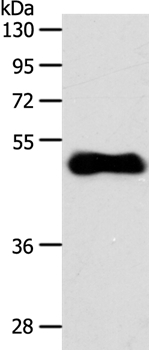Product Detail
Product NameS1PR3 Antibody
Host SpeciesRabbit
ClonalityPolyclonal
PurificationAntigen affinity purification.
ApplicationsWB IHC
Species ReactivityHu
SpecificityThe antibody detects endogenous levels of total S1PR3 protein.
Immunogen TypePeptide
Immunogen DescSynthetic peptide corresponding to a region derived from internal residues of human Sphingosine-1-phosphate receptor 3
Target NameS1PR3
ConjugateUnconjugated
Other NamesEDG3; LPB3; S1P3; EDG-3
Accession NoSwiss-Prot#: Q99500
NCBI Gene ID: 1903
Gene Accssion: NP_005217
Uniprot
Q99500
Gene ID
1903;
Sdspage MW42kd
Concentration1.4mg/ml
FormulationRabbit IgG in pH7.4 PBS, 0.05% NaN3, 40% Glycerol.
StorageStore at -20˚C
Application Details
Western blotting: 1:1000-1:5000
Immunohistochemistry: 1:25-1:100
Gel: 10%SDS-PAGE
Lysates (from left to right): Human fetal brain tissue
Amount of lysate: 40ug per lane
Primary antibody: 1/700 dilution
Secondary antibody dilution: 1/8000
Exposure time: 20 seconds
Immunohistochemical analysis of paraffin-embedded Human cervical cancer tissue using #37289 at dilution 1/30.
This gene encodes a member of the EDG family of receptors, which are G protein-coupled receptors. This protein has been identified as a functional receptor for sphingosine 1-phosphate and likely contributes to the regulation of angiogenesis and vascular endothelial cell function. Receptor for the lysosphingolipid sphingosine 1-phosphate (S1P). S1P is a bioactive lysophospholipid that elicits diverse physiological effect on most types of cells and tissues. When expressed in rat HTC4 hepatoma cells, is capable of mediating S1P-induced cell proliferation and suppression of apoptosis.
If you have published an article using product 37289, please notify us so that we can cite your literature.
et al,ApoM-S1P Modulates Ox-LDL-Induced Inflammation Through the PI3K/Akt SignalIng Pathway In HUVECs. In Inflammation on 2019 Apr by Zheng Z, Zeng Y,et al.. PMID:30377890
, (2019),
PMID:
30377890




 Yes
Yes



